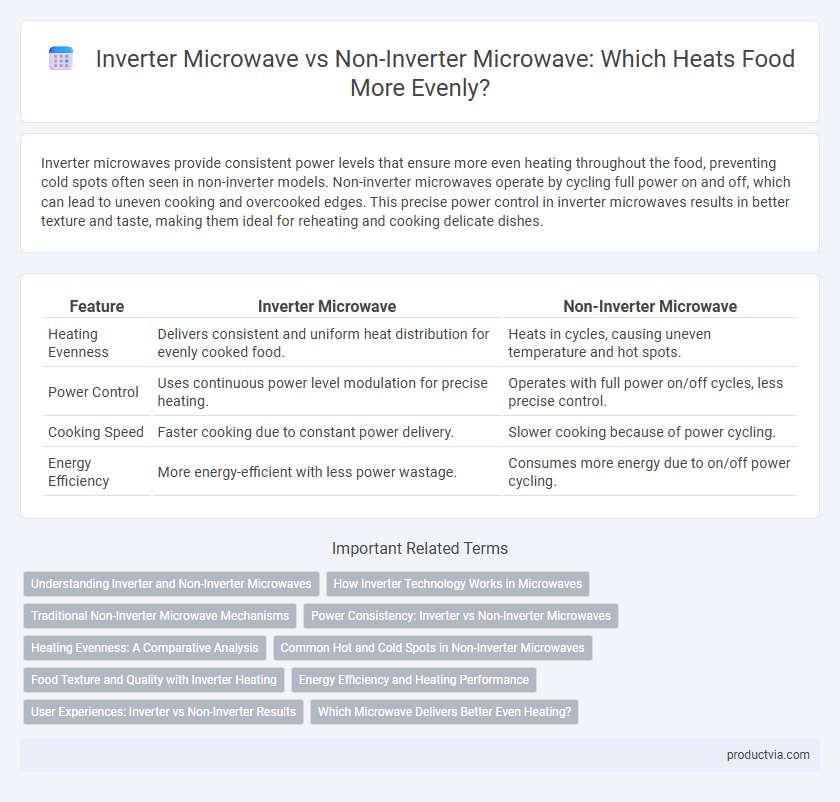Inverter microwaves provide consistent power levels that ensure more even heating throughout the food, preventing cold spots often seen in non-inverter models. Non-inverter microwaves operate by cycling full power on and off, which can lead to uneven cooking and overcooked edges. This precise power control in inverter microwaves results in better texture and taste, making them ideal for reheating and cooking delicate dishes.
Table of Comparison
| Feature | Inverter Microwave | Non-Inverter Microwave |
|---|---|---|
| Heating Evenness | Delivers consistent and uniform heat distribution for evenly cooked food. | Heats in cycles, causing uneven temperature and hot spots. |
| Power Control | Uses continuous power level modulation for precise heating. | Operates with full power on/off cycles, less precise control. |
| Cooking Speed | Faster cooking due to constant power delivery. | Slower cooking because of power cycling. |
| Energy Efficiency | More energy-efficient with less power wastage. | Consumes more energy due to on/off power cycling. |
Understanding Inverter and Non-Inverter Microwaves
Inverter microwaves utilize a continuous power flow mechanism, allowing precise and consistent energy levels that result in evenly heated food without cold spots. Non-inverter microwaves operate with a traditional on-off cycling of full power, causing uneven heating due to fluctuating energy output. Understanding this fundamental difference highlights why inverter technology delivers superior temperature control and consistent cooking results.
How Inverter Technology Works in Microwaves
Inverter microwave technology delivers continuous and precise power levels by modulating the electrical current, allowing for consistent and even heating throughout food. Unlike non-inverter microwaves that cycle between full power and no power, inverter models maintain a steady energy flow, preventing hot and cold spots. This results in more uniform cooking and defrosting, enhancing texture and taste in microwave-heated dishes.
Traditional Non-Inverter Microwave Mechanisms
Traditional non-inverter microwaves operate using a fixed power cycling method where the magnetron alternates between full power and zero power to control heating. This on-off cycle often leads to uneven heating, as food is periodically exposed to intense microwave energy followed by cooling intervals. The lack of continuous power adjustment results in hot and cold spots, reducing overall heating uniformity compared to inverter microwave technology.
Power Consistency: Inverter vs Non-Inverter Microwaves
Inverter microwaves provide consistent power delivery by modulating energy levels, ensuring more even heating throughout the food compared to non-inverter models that cycle power on and off. Non-inverter microwaves operate at full power until the timer runs out, leading to uneven heating with hot and cold spots. Power consistency in inverter technology enhances cooking precision and energy efficiency for better overall heating performance.
Heating Evenness: A Comparative Analysis
Inverter microwaves deliver precise power control by continuously adjusting the energy output, resulting in consistently even heating and reduced cold spots. Non-inverter microwaves rely on a fixed power cycling method, causing uneven heating with frequent overheating and underheating in different areas. Advanced inverter technology enhances temperature stability, making it the preferred choice for uniform food heating.
Common Hot and Cold Spots in Non-Inverter Microwaves
Non-inverter microwaves often produce common hot and cold spots due to their power cycling method, which alternates between full power and no power, leading to uneven heating. In contrast, inverter microwaves use continuous and variable power levels, providing more consistent energy distribution for uniform heating. This results in fewer hot and cold spots, ensuring food is heated evenly throughout.
Food Texture and Quality with Inverter Heating
Inverter microwave technology provides consistent power levels for more precise heating, resulting in improved food texture and even cooking compared to non-inverter models that cycle power on and off. This continuous energy delivery prevents overcooking edges while ensuring the center heats thoroughly, preserving moisture and maintaining the original quality of the food. Inverter microwaves excel in defrosting, reheating, and cooking delicate dishes, enhancing overall culinary results by minimizing hot spots and uneven texture.
Energy Efficiency and Heating Performance
Inverter microwaves provide precise power control by continuously adjusting energy output, resulting in more even heating and improved energy efficiency compared to non-inverter models that cycle power on and off. This consistent energy delivery reduces cold spots and overcooked edges, enhancing food quality while conserving electricity. Non-inverter microwaves often lead to uneven heating and higher energy consumption due to their less efficient power modulation.
User Experiences: Inverter vs Non-Inverter Results
Inverter microwaves provide more consistent heating by delivering a steady stream of power, which helps avoid cold spots and uneven cooking, as reported by many users who praise their ability to warm food uniformly. Non-inverter microwaves operate using a full-power-on or full-power-off cycle, causing fluctuations that often result in uneven heating and cold patches in dishes. User experiences consistently highlight that inverter technology enhances meal quality and saves time by reducing the need for stirring or reheating.
Which Microwave Delivers Better Even Heating?
Inverter microwaves provide more consistent cooking power by using a steady stream of energy, which results in even heating and reduces cold spots in food compared to non-inverter models. Non-inverter microwaves operate on a simple on-and-off power cycle, causing uneven heat distribution and often leading to overheated edges and undercooked centers. For applications requiring precise and uniform heating, inverter microwaves deliver superior performance and improved cooking results.
Inverter Microwave vs Non-Inverter Microwave for Heating Evenness Infographic

 productvia.com
productvia.com